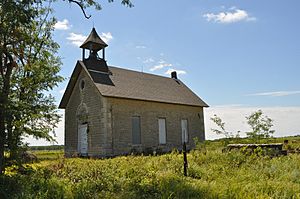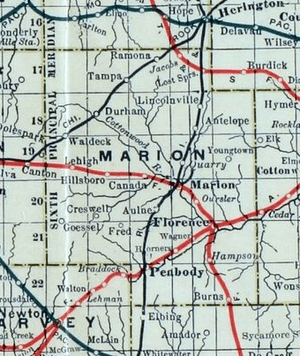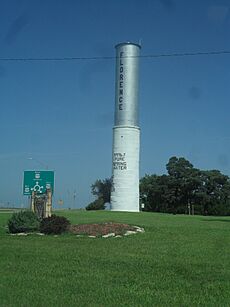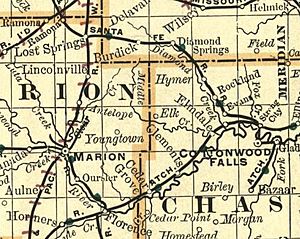Florence, Kansas facts for kids
Quick facts for kids
Florence, Kansas
|
|
|---|---|
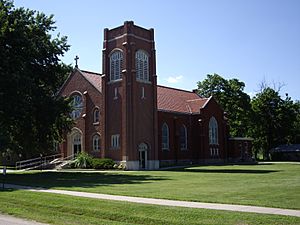
St Patrick Catholic Church (2010)
|
|
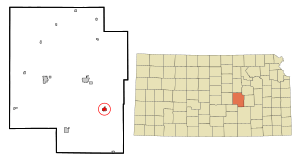
Location within Marion County and Kansas
|
|
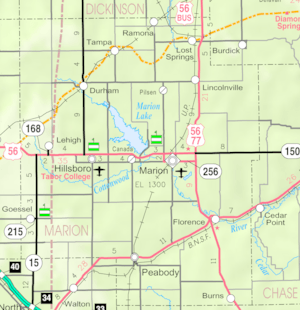
|
|
| Country | United States |
| State | Kansas |
| County | Marion |
| Township | Doyle, Fairplay |
| Platted | 1870 |
| Incorporated | 1872 |
| Named for | Florence Crawford |
| Government | |
| • Type | Mayor–Council |
| Area | |
| • Total | 0.77 sq mi (1.99 km2) |
| • Land | 0.77 sq mi (1.98 km2) |
| • Water | 0.00 sq mi (0.00 km2) |
| Elevation | 1,270 ft (390 m) |
| Population
(2020)
|
|
| • Total | 394 |
| • Density | 512/sq mi (198.0/km2) |
| Time zone | UTC-6 (CST) |
| • Summer (DST) | UTC-5 (CDT) |
| ZIP code |
66851
|
| Area code | 620 |
| FIPS code | 20-23600 |
| GNIS ID | 485574 |
Florence is a small city in Marion County, Kansas, United States. In 2020, about 394 people lived there. The city was named after Florence Crawford, the daughter of Samuel J. Crawford, who was the third Governor of Kansas. Florence is located where two important highways, U.S. Route 50 and U.S. Route 77, meet.
History of Florence
Early Times
For thousands of years, the Great Plains of North America were home to nomadic Native American tribes. Some of these tribes included the Arapaho, Cheyenne, Comanche, Kansa, Kiowa, Osage, Pawnee, and Wichita.
Later, from the 1500s to the 1700s, the Kingdom of France claimed a large part of North America. In 1762, after a war, France secretly gave this land to Spain. But in 1802, Spain gave most of it back to France.
Becoming Part of the U.S.
In 1803, the United States bought a huge area of land from France. This was called the Louisiana Purchase. It included most of what is now Kansas. In 1806, an explorer named Zebulon Pike traveled through this area, following the Cottonwood River near where Florence is today.
In 1854, the Kansas Territory was created. Then, in 1861, Kansas officially became the 34th U.S. state. Marion County, where Florence is, was set up in 1855.
Founding of Florence
The first settlers in Marion County arrived near Doyle Creek, close to where Florence is now. Moses Shane came in 1858, and Patrick Doyle, who gave his name to the creek and township, arrived in 1859.
A group of men called the Florence Town Company decided to create a new town. They knew the Atchison, Topeka and Santa Fe Railway planned to build tracks through the area. They picked a spot where the railroad would cross the Cottonwood River.
On December 1, 1870, the Florence Town Company was officially formed. Samuel J. Crawford, a former Governor of Kansas, was the president. He named the town Florence after his daughter, Miss Florence Crawford. The town was officially incorporated in 1872.
Railroads and the Harvey House
In 1871, the Atchison, Topeka and Santa Fe Railway built its main line through Florence. This railroad later became part of the BNSF Railway. Even today, many locals still call it the "Santa Fe" railroad.
Florence became an important stop for travelers. In 1877, Fred Harvey, a businessman famous for starting one of the first restaurant chains in the U.S., bought a hotel near the Florence train station. In 1878, he opened the second Harvey House Restaurant in Florence. This was special because it was the first Harvey House to offer both food and sleeping rooms.
20th Century Changes
Florence has experienced several floods over the years. In 1951, heavy rains caused major floods across Kansas, including Florence. Because of this, many reservoirs and levees (protective walls) were built. The Marion Reservoir was built nearby between 1964 and 1968 to help control flooding.
Geography and Climate
Florence covers about 0.77 square miles (1.99 square kilometers) of land.
Climate
The weather in Florence has hot, humid summers. Winters are usually mild to cool. This type of weather is known as a humid subtropical climate.
Area Events
Florence hosts several fun events throughout the year:
- Florence Labor Day Celebration: This is a long-standing tradition, celebrating its 76th year in 2013.
- Florence High School Alumni Banquet: Former students gather for this event, which was in its 117th year in 2013.
- Harvey House Picnic: An annual picnic held in June.
- Tour de Florence: A mountain bike tour that explores the Flint Hills area around Florence, usually held in October.
Area Attractions
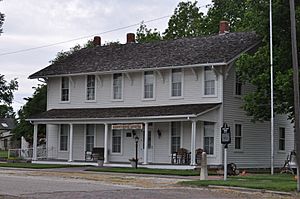
Florence has several historic buildings that are listed on the National Register of Historic Places (NRHP). This means they are important places that are protected.
- 1876 Harvey House: Located at 221 North Marion Street. This building was part of the original Clifton Hotel. It became the first Harvey House to offer both meals and rooms for travelers on the Atchison, Topeka and Santa Fe Railway. Today, it's a museum.
- 1881 Doyle Place: This house is south of the railroad tracks on Main Street. It's a beautiful example of the Italian Villa style and was built from local stone. The original owner, Patrick Doyle, gave his name to Doyle Creek and the township. It is not open to the public.
- 1896 Bichet School: About 3 miles east of Florence. This school was built from local stone to teach French-speaking immigrant children. It is not open to the public.
- 1887 Florence Water Tower: Located at 525 West 5th Street. This unique water tower was built using local materials in the late 1800s.
- Florence Opera House: Located at the southwest corner of 5th and Main Streets.
Films and TV in Florence
Florence has been a filming location for some movies and TV shows:
- Feasting on Asphalt (2006): TV chef Alton Brown visited Florence's Spring Fling event and the Harvey House for an episode.
- Mary White (1977): Scenes for this TV movie about the daughter of Kansas journalist William Allen White were filmed in Florence.
- Music Video (2002): A music video was filmed over five days around the 1896 Bichet School.
Population Information
| Historical population | |||
|---|---|---|---|
| Census | Pop. | %± | |
| 1880 | 954 | — | |
| 1890 | 1,229 | 28.8% | |
| 1900 | 1,178 | −4.1% | |
| 1910 | 1,168 | −0.8% | |
| 1920 | 1,517 | 29.9% | |
| 1930 | 1,493 | −1.6% | |
| 1940 | 1,329 | −11.0% | |
| 1950 | 1,009 | −24.1% | |
| 1960 | 853 | −15.5% | |
| 1970 | 777 | −8.9% | |
| 1980 | 729 | −6.2% | |
| 1990 | 636 | −12.8% | |
| 2000 | 671 | 5.5% | |
| 2010 | 465 | −30.7% | |
| 2020 | 394 | −15.3% | |
| U.S. Decennial Census | |||
2020 Census Details
In 2020, the 2020 United States census counted 394 people living in Florence. There were 189 households and 95 families. Most residents (91.37%) were white. About 5.08% of the population was Hispanic or Latino.
About 21.6% of the people were under 18 years old. The average age in Florence was 50.6 years. The median household income was about $35,833.
2010 Census Details
In 2010, there were 465 people living in Florence. The city had 216 households. Most people (95.1%) were white. About 3.4% of the population was Hispanic or Latino.
The average age in the city was 46.1 years. About 21.7% of residents were under 18 years old.
Education in Florence
Schools
The public schools in Florence are part of the Marion–Florence USD 408 school district. Florence's own schools have closed, so students now attend schools in Marion.
- Marion High School
- Marion Middle School
- Marion Elementary School
Library
The Florence Public Library serves the community. It is located at 324 North Main Street.
Local News
To stay updated on local news, residents can read:
- Peabody Gazette-Bulletin: This newspaper covers news for Florence and nearby towns like Burns and Peabody.
- Marion County Record: This newspaper focuses on news for Marion.
City Services
Transportation
Two major highways, U.S. Route 50 and U.S. Route 77, meet in Florence. This intersection used to have many accidents. To make it safer, the Kansas Department of Transportation changed it into a large roundabout in 2006. This helped reduce accidents.
The BNSF Railway also runs through Florence, close to U.S. Route 50.
Utilities
Florence provides various services to its residents:
- Internet: Available through cable (Vyve), wireless (KwiKom), and satellite (HughesNet, StarBand, WildBlue).
- TV: Available through cable (Vyve), satellite (DirecTV, Dish Network), and local digital TV stations.
- Electricity: Provided by Flint Hills RECA for rural areas.
- Water, Sewer, and Trash: Services are provided by the City of Florence.
Famous People from Florence
- J. Ware Butterfield (1838-): A lawyer who served in the Kansas House of Representatives.
- Charles Fuller (1825–1879): A businessman and farmer who also served in the Kansas House of Representatives.
- J. K. McLean: Another person who served in the Kansas House of Representatives.
- Sharon M. Savage: She was crowned Miss Kansas in 1964.
See also
 In Spanish: Florence (Kansas) para niños
In Spanish: Florence (Kansas) para niños


